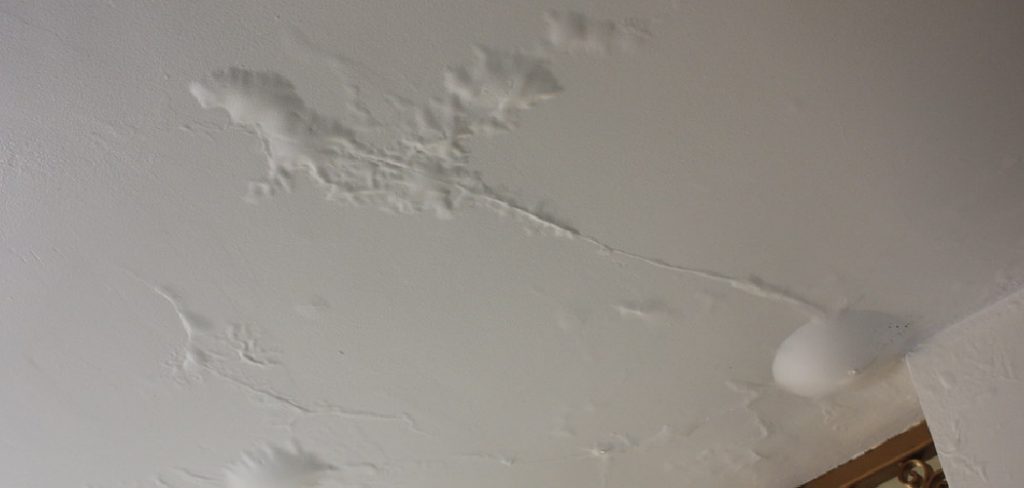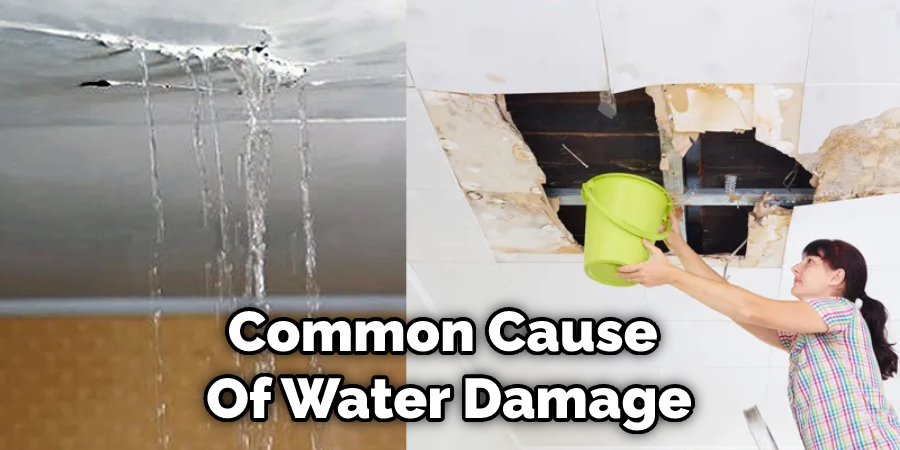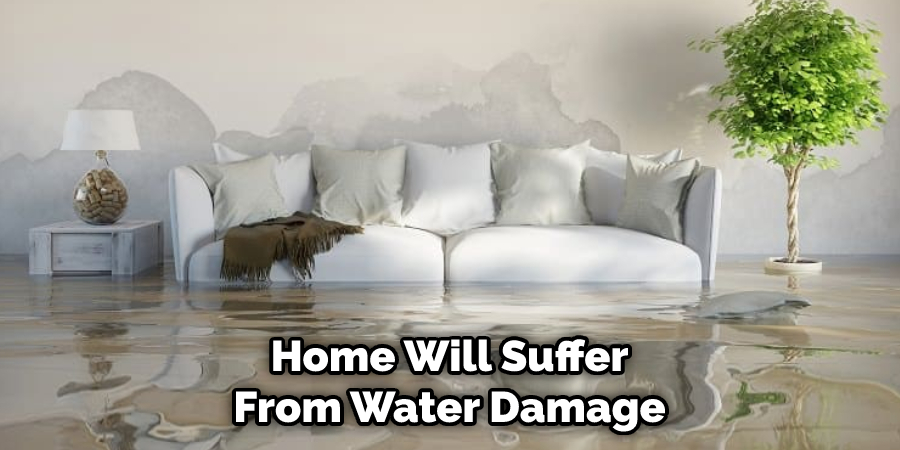If your home has been affected by water damage, it is important to take steps to fix the damage as soon as possible. Water damage can cause structural and other serious issues if not addressed quickly. If your home has water damage, it’s important to take action as soon as possible.

Not only is the water a safety hazard, but left untreated, it can lead to even more damage in the future. In this blog post, we will discuss some of the steps you can take how to fix water damaged wall. We will also provide some tips on how to prevent water damage in the future. Read on for more information.
Summary: Water damage to walls can be caused by a variety of factors including flooding, plumbing leaks, and bad weather. There are a few steps you can take to repair water damaged walls and prevent further damage.
These include removing any wet items, using fans and dehumidifiers to remove additional moisture, patching the wall with drywall compound, and sealing cracks with waterproof caulk. With proper care and maintenance, you can keep your walls looking like new!
10 Reasons That Causes Water Damaged Wall:
1. Plumbing Leaks:
One of the most common causes of water damage is plumbing leaks. These can happen in any part of your home but are most common in bathrooms and kitchens. The plumbing leaks happen because of old or corroded pipes, fixtures, and fittings.
2. Roof Leaks:
Another common cause of water damage is roof leaks. These can be caused by various things, including wind damage, missing shingles, and cracked flashing. If you suspect a roof leak, it’s important to have it fixed as soon as possible to avoid further damage. When water leaks through the roof, it can cause damage to the ceilings, walls, and insulation.
3. Storm Damage:
Storms can cause a lot of damage to your home, including water damage. In addition, high winds can cause tree limbs to fall on your roof, and rain can cause leaks. If a storm has damaged your home, it’s important to have the damage repaired as soon as possible to prevent further damage. Make sure a professional inspects your home for damage after a storm.
4. Burst Pipes:
Burst pipes are another common cause of water damage. Pipes can burst for various reasons, including freezing temperatures and excessive pressure. If you have a burst pipe, it’s important to shut off the water and call a professional as soon as possible. Burst pipes can cause a lot of damage in a short amount of time, so it’s important to take action quickly.

5. Sewage Backup:
A sewage backup is one of the most serious kinds of water damage. If you have sewage water in your home, it’s important to act fast. Sewage water can contain harmful bacteria and viruses that can cause serious illness. Call a professional cleanup crew immediately if you have sewage water in your home. When the sewage water is removed, you’ll need to have the affected area professionally cleaned and disinfected.
6. Foundation Cracks:
Water can enter through cracks in your home’s foundation and cause serious damage. If you see any cracks, seal them with a waterproofing compound as soon as possible. If the water damage is severe, you may need to call a professional to repair the cracks. The water seeps in can weaken the foundation and lead to serious structural problems.
7. Gutters and Downspouts:
Make sure your gutters and downspouts are clean and in good repair. Clogged gutters can cause water to back up and seep into your home’s exterior walls. This can lead to serious problems like water damage, foundation issues, mold, and mildew growth. If the gutters are beyond repair, replace them with new ones.

8. Improper Grading:
If your home’s grading slopes towards the foundation, water can pool around the foundation and cause serious damage. The best way to prevent this is to ensure the grading slopes away from the foundation. You can add soil and ensure the gutters are clean and in good repair.
9. Poor Ventilation:
If your home doesn’t have proper ventilation, it can cause various problems, including water damage. Poor ventilation can cause moisture to build up in the air and condensation on walls and ceilings. This can eventually lead to mold and mildew growth. If you suspect your home doesn’t have proper ventilation, call a professional to inspect it.
10. Leaking Windows:
Leaking windows are one of the most common causes of water damage. The leaks can be caused by various things, including faulty installation, sealant problems, and cracked glass. If you have leaking windows, it’s important to have them fixed as soon as possible to prevent further damage.
15 Effective Steps on How to Fix Water Damaged Wall
Step 1: Assess the Damage
Before starting the repair process, assess the extent of the water damage to your wall. Identify the source of the moisture to prevent further damage. Water damage can be caused by various factors, such as leaks from pipes, roofs, or appliances, and can range from minor discoloration to severe structural damage.
Step 2: Turn Off Electricity and Water Supply
For safety reasons, turn off the electricity and water supply in the affected area. You can do this by switching off the circuit breakers or shutting off the main water valve. This precaution will help prevent electrocution and additional water damage during the repair process.
Step 3: Remove Damaged Materials
Begin by removing any damaged materials from the affected area. This may include peeling paint, wallpaper, or damaged drywall. Use a utility knife or putty knife to carefully remove loose materials without causing further damage to the surrounding areas.
Step 4: Dry the Affected Area
Once the damaged materials have been removed, thoroughly dry the affected area. You can use fans, dehumidifiers, or heaters to speed up the drying process. Be sure to properly ventilate the space by opening windows and doors. Drying the area may take several days, depending on the extent of the water damage.
Step 5: Treat Mold and Mildew
If mold or mildew is present, it is essential to treat the affected area to prevent further growth. Use a mixture of water and bleach or a commercial mold remover to clean the affected surfaces. Wear protective gloves, goggles, and a mask when handling moldy materials. Allow the area to dry completely after treatment.
Step 6: Repair the Drywall
If the water damage has caused structural damage to the drywall, you will need to repair or replace the affected sections. To repair small holes or cracks, use a joint compound or patching compound. Apply the compound with a putty knife and smooth it out to create an even surface. For larger holes, you may need to cut out the damaged section and replace it with a new piece of drywall. Secure the new drywall piece with screws and cover the seams with joint tape and compound. Sand the repaired area smooth once the compound has dried.
Step 7: Repair the Plaster (If Applicable)
If your wall is made of plaster, repair any damaged areas using a patching compound specifically designed for plaster. Apply the compound with a putty knife and smooth it out to create an even surface. Allow the compound to dry completely, then sand the repaired area smooth.
Step 8: Prime the Repaired Area
Before repainting the repaired area, apply a primer to seal the surface and prevent moisture from seeping through. Use a primer specifically designed for use on water-damaged surfaces to ensure the best results. Allow the primer to dry completely before proceeding to the next step.
Step 9: Paint the Repaired Area
Once the primer is dry, you can repaint the repaired area to match the rest of the wall. Use a high-quality, water-resistant paint to help protect the wall from future water damage. Apply the paint in thin, even coats, allowing each coat to dry before applying the next. Be sure to feather the edges of the painted area to blend it seamlessly with the surrounding wall.
Step 10: Inspect and Maintain Your Wall
After completing the repair, regularly inspect your wall for signs of water damage or mold growth. Address any issues promptly to prevent further damage. Maintain your wall by promptly addressing any leaks or moisture issues and keeping the area well-ventilated.
By following these steps, you can effectively repair a water-damaged wall and restore it to its original appearance and function. The key to a successful repair is addressing the root cause of the water damage and ensuring that the affected area is thoroughly dried and treated for mold and mildew. Proper maintenance and prompt attention to any future leaks or moisture issues will help prevent additional water damage and keep your wall in good condition for years to come.
Step 11: Insulate and Seal Your Home
To prevent future water damage, it is essential to insulate and seal your home properly. Check for cracks or gaps in your home’s exterior, including around windows, doors, and any penetrations such as pipes, vents, or cables. Use caulk or weatherstripping to seal any gaps or cracks, and insulate your walls, attic, and crawl spaces to keep moisture out and maintain a consistent indoor temperature.
Step 12: Maintain Gutters and Downspouts
Regularly clean and maintain your gutters and downspouts to prevent water from overflowing and causing damage to your home’s exterior and foundation. Ensure that your downspouts direct water at least 6 feet away from your home to prevent water from seeping into your walls and causing damage.
Step 13: Monitor Plumbing and Appliances
Regularly inspect your home’s plumbing system and appliances for leaks or signs of wear. Repair or replace any damaged pipes, hoses, or fittings to prevent water damage. If you notice any unusual moisture or water stains on your walls, address the issue immediately to prevent further damage.
Step 14: Install a Sump Pump and Dehumidifier (If Necessary)
If your home is prone to flooding or has a high moisture level, consider installing a sump pump in your basement or crawl space to prevent water damage. Additionally, a dehumidifier can help maintain a healthy humidity level in your home, preventing mold growth and moisture-related damage.
Step 15: Educate Your Family
Teach your family members about the signs of water damage and the importance of addressing any issues promptly. Encourage them to report any leaks, moisture issues, or mold growth so that you can take action to prevent further damage.
By taking these preventive measures and maintaining your home, you can minimize the risk of water damage to your walls and protect the overall structure and appearance of your home. Remember that regular inspections, prompt repairs, and proper maintenance are crucial to keeping your walls in good condition and preventing costly water damage repairs in the future.
Tips to Prevent Water Damage Wall in the Future
Here we have given tips on how to fix water damaged walls.
- Inspect your home regularly for signs of water damage.
- Be sure to fix any leaks or other water problems as soon as possible.
- Keep gutters and downspouts clean and in good repair.
- Make sure that your home’s foundation is in good condition and that there are no cracks or other openings that could allow water to seep in.
- If you live in an area prone to flooding, be sure to take precautions to protect your home against flood waters.
- Be aware of the risk of pipe bursts and other plumbing problems during cold weather and take steps to prevent them.
- Take measures to prevent seepage through basement walls and floors.
- Keep your home in good repair overall to help prevent water damage.
If you have experienced water damage in your home, these tips can help you deal with the problem and prevent it from happening again.

Can You Paint Over Water Damaged Walls?
It’s inevitable. At some point, every home will suffer from water damage. Whether it’s a faulty appliance, bad weather, or a leaky roof, water can cause serious problems for your walls. If you’re lucky, the damage will be limited to a small area and can be easily fixed with a little paint. But if the damage is extensive, you may need to replace the entire wall. If you’re dealing with water damage, you first need to assess the situation.
If the damage is minimal, you may be able to get away with painting over it. But if the damage is more extensive, you’ll need to take more drastic measures. Once you’ve determined the extent of the damage, you can start to take steps to fix it. For example, you can start cleaning the area with a damp cloth if the damage is minor. Be sure to use gentle strokes and avoid scrubbing too hard, as this could damage the wall further.
What Happens if Water Gets in Your Walls?
Water damage to your walls can cause many problems, from peeling paint to warped wood and mold growth. And if the water is allowed to sit for too long, it can lead to serious structural damage. That’s why it’s important to act quickly if you notice any signs of water damage, such as damp patches or water stains.
The first step is to identify the source of the water and stop it from coming in. This might mean fixing a leaky pipe or repairing a damaged roof. Once the source of the problem has been stopped, you can start the repair process. If the damage is minor, you might be able to fix it yourself with some basic supplies from the hardware store. But if the damage is more severe, you’ll need to call in a professional.
Frequently Asked Questions
Can You Just Paint Over Water Damage?
It will vary depending on the extent of the damage and whether or not you are able to remove any existing materials. However, if water damage is relatively minor, painting may be an option. If there is significant water damage (e.g., wet paint that has seeped underneath walls), then removing all affected materials may be necessary in order for the area to be salvageable.
Can You Paint Over Water Damage Wall?
There are a few ways to deal with water damage walls – the most common of which is to remove the affected area and then start patching the damage with drywall or plaster. If the area is too large or delicate for either of those options, then you might be able to salvage it by painting over the damage.
However, this will only work if the paint will adhere to the wall and not peel or flake off over time. Additionally, make sure to test the paint’s compatibility before you start painting – some paints are not recommended for use on water-damaged surfaces.
If you decide to go ahead and paint over a water-damaged wall, be sure to use a quality product that will stand up to wear and tear. Also, be sure to follow any safety guidelines that are specific to this type of painting job. Hope this helps!
Should You Replace Wet Drywall?
The decision of whether or not to replace wet drywall depends on a number of factors. However, some general tips that may be helpful include taking into account the age and condition of your walls, what type of insulation you are using, and whether or not water has been leaking onto your flooring from above.
If you decide to replace wet drywall, it’s important to carefully assess the damage so that you can choose the proper grade and amount for installation. Make sure that everything is properly sealed including cracks and joints before beginning work in order to protect your home from future moisture issues. Finally, be sure to hire an experienced contractor who will take care during and after installation so that your walls look brand new once finished!
Can You Tell How Old Water Damage is?
Unfortunately, there is no surefire way to determine how old water damage is. Depending on the chemicals used in the restoration process and the conditions of your home, it may be difficult to tell how long ago the water damage occurred. In some cases, you might be able to see mold or mildew growth that was not present before the incident. However, this will not always indicate recent water damage.
If you’re concerned about potential health risks associated with old water damage, it’s best to consult with a professional who can assess your situation and advise you on any safety precautions that need to be taken. Additionally, keep an eye out for changes in behavior or symptoms that might signal something more serious is going on.
Final Thoughts
Water damage is a common problem that can occur in any home. Unfortunately, walls are often the first place water damage is visible. There are several ways how to fix water damaged walls, and each method depends on the severity of the damage. In this blog post, we have discussed a few common methods for repairing water-damaged walls.
Each method has its pros and cons, so choosing the right method for your specific situation is essential. By following the tips in this article, you can minimize the damage caused by water and speed up the repairs. Have you ever had to deal with water damage? What tips do you have to share? Let us know in the comments.
